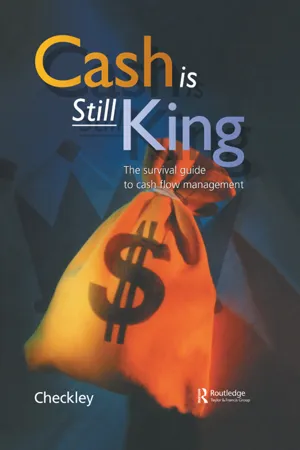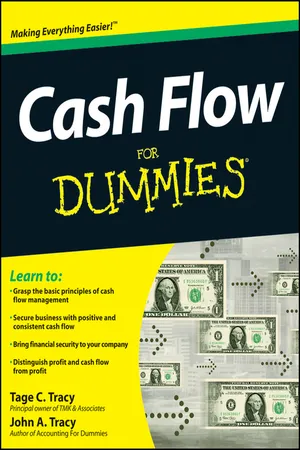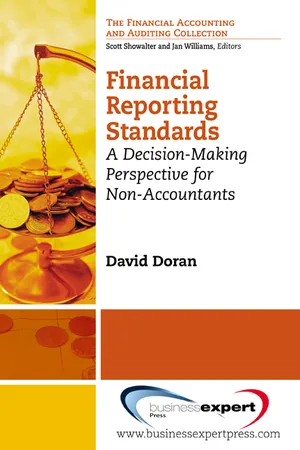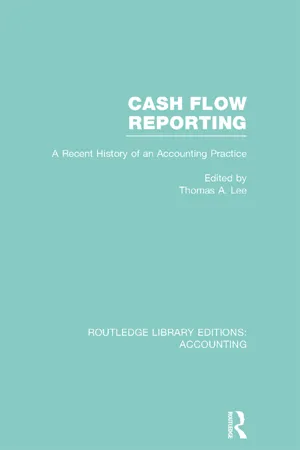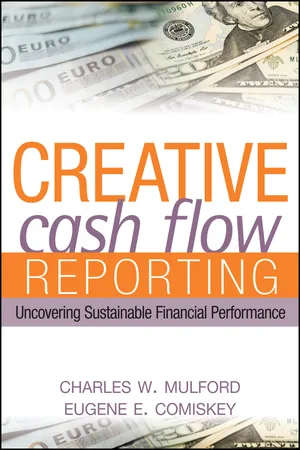Business
Cash Flow
Cash flow refers to the movement of money into and out of a business. It is a crucial measure of a company's financial health, indicating its ability to meet financial obligations, invest in growth, and generate profits. Positive cash flow means more money is coming in than going out, while negative cash flow indicates the opposite.
Written by Perlego with AI-assistance
Related key terms
Related key terms
1 of 4
Related key terms
1 of 3
11 Key excerpts on "Cash Flow"
- Michael Chibili(Author)
- 2019(Publication Date)
- Routledge(Publisher)
5The Cash Flow statement (also called the statement of Cash Flow)
5.1 Cash in the business5.2 Establishing Cash Flow statements5.3 A worked example in the establishment of the SCF using the indirect methodCompanies can only survive if they have enough cash in hand to be able to take care of all their expenses. Cash is considered as the lifeblood of any business. Users of financial statements who assess only the statement of profit and loss to try and determine the financial health of the company might later on realize that their assessment may have been incorrect. Profitable companies have been known to have suddenly failed because they did not adequately manage their Cash Flows. An understanding of the importance and management of cash is a must if any company’s management would want to avoid sudden liquidity problems. Section 5.1 discusses the place of cash in a business, while at the same time differentiating profits from cash. Section 5.2 provides the rules in the establishment of the Cash Flow statement, while Section 5.3 is a worked example of the Cash Flow statement using one of the well established methods.5.1 Cash in the business
Cash is money, in the form of notes and coins, which constitutes payment for goods or services at the time of their purchase or consumption. Cash is not only cash in hand but also deposits and overdrafts which are commonly called cash equivalents. All transactions whether they are settled immediately or settled in the future are ultimately conducted by cash or cash equivalents. Just like all other assets, cash is an asset with the same properties like other assets, and also many more. The structure of the subsections is as follows:- eBook - ePub
- Thomas R. Robinson, Elaine Henry, Wendy L. Pirie, Michael A. Broihahn(Authors)
- 2015(Publication Date)
- Wiley(Publisher)
Solution: On both measures—operating Cash Flow divided by revenue and operating Cash Flow divided by assets—Apple's performance was much stronger than the two comparable companies. Dell's operating Cash Flow divided by revenue is lower than HP's for all three years. Dell's operating Cash Flow relative to assets is similar to HP's in 2009, lower than HP's in 2008, and higher than HP's in 2007. Apple's measures are significantly higher than the others, indicating that it has the best cash generating ability. Note that Apple's cash generating ability presumably reflects the company's successful introduction and sales of new products (including the iPhone), tightly managed inventory, and ability to generate revenues (and operating Cash Flow) from businesses not requiring significant investment in such assets as service contracts and sales of third-party compatible products. Overall, Potter should undertake additional research to understand the underlying business reasons for the differences in the companies' Cash Flow profiles.5. Summary
The Cash Flow statement provides important information about a company's cash receipts and cash payments during an accounting period as well as information about a company's operating, investing, and financing activities. Although the income statement provides a measure of a company's success, cash and Cash Flow are also vital to a company's long-term success. Information on the sources and uses of cash helps creditors, investors, and other statement users evaluate the company's liquidity, solvency, and financial flexibility. Key concepts are as follows:- Cash Flow activities are classified into three categories: operating activities, investing activities, and financing activities. Significant non-cash transaction activities (if present) are reported by using a supplemental disclosure note to the Cash Flow statement.
- eBook - ePub
- Bev Vickerstaff, Parminder Johal(Authors)
- 2014(Publication Date)
- Routledge(Publisher)
Having established the information that goes into the Cash Flow statement we are now able to determine what the Cash Flow statement is saying about a company’s cash position. Almost instantly the Cash Flow statement can show the movement of cash in the year, by looking at the net increase/decrease in cash and cash equivalents towards the end of the Cash Flow statement. An increase in profits cannot be translated as a positive cash balance. This has been illustrated by the collapse of many profitable companies over the years.By separating out Cash Flows under the various headings (Cash Flows from operating activities; Cash Flows from investing activities and Cash Flows from financing activities) it is possible to determine by how much each activity type has been responsible for the cash increase or decrease, and thus the solvency position of the company.This enables an analysis of further issues such as:• Is the company able to pay a dividend? • What is the level of spending on non-current assets? • Has the company raised new finance? • Why is the company showing a negative Cash Flow from operating activities? Is the company able to pay a dividend?Typically, most organizations in the UK prefer to pay a dividend as there is a school of thought that suggests that this can send out a positive signal to existing and potential shareholders about the ability and performance of the company. However, when the economy is depressed, many companies may find they do not have the cash available to pay the dividend. The Cash Flow statement can help determine what the company’s overall cash position is and how it will be affected by a dividend payout. The article below provides a real-life example of this. - eBook - ePub
- Keith Checkley(Author)
- 2012(Publication Date)
- Routledge(Publisher)
1 Cash Flow AND BUSINESS
Cash Flows are normally reported in a Cash Flow Statement . In the United Kingdom this is prepared in accordance with Financial Reporting Standard (FRS) No. 1 - Cash Flow Statements. In countries that have adopted international accounting standards it is prepared in accordance with International Accounting Standard (IAS) No. 7 - Cash Flow Statements. The Cash Flow Statement is a relatively recent phenomenon. FRS 1 was issued in the United Kingdom in September 1991. IAS 7, having originally been called Statement of Changes in Financial Position, was revised in 1992 and retitled Cash Flow Statements. Prior to this the UK and many other countries required a Statement of Source and Application of Funds in the annual accounts which, while being a document that assisted in the analysis of Cash Flows, was not a Cash Flow statement and proved difficult to interpret.Ever since the joint stock company was invented in the 1800s it has been customary to offer shareholders an annual Profit and Loss Account and Balance Sheet. However, professional analysts have realized that Cash Flows are essentially a matter of fact and are therefore much less prone to accounting interpretation by managers and directors of companies. Consequently we are now seeing much more emphasis being placed on the identification and analysis of Cash Flows as opposed to the traditional approach of data derived from the Profit and Loss Account and Balance SheetSee overleaf for extract from FRS 1 - Illustrative exampleXYZ LIMITEDNote to the Cash Flow statement
Reconciliation of operating profit to net cash inflow from operating activities:1. Net cash inflow from operating activities
The identification starts with operating profit, and the next two items are depreciation and the (profit)/loss on sale of fixed assets, which are added back. The objective is to identify the cash generated from operations . This is normally achieved by adding back to operating profit all non-cash items - eBook - ePub
Corporate Finance
Theory and Practice
- Pierre Vernimmen, Pascal Quiry, Maurizio Dallocchio, Yann Le Fur, Antonio Salvi(Authors)
- 2017(Publication Date)
- Wiley(Publisher)
Conversely, the circle becomes a vicious one if the company’s resources are constantly tied up in new investments or if Cash Flow from operating activities is chronically low. The company systematically needs to borrow to finance capital expenditure, and it may never be able to pay off its debt, not to mention pay dividends.Evaluating these matters is the dynamic approach.- In parallel with the dynamic approach, you must look at the current state of the company’s finances with two questions in mind:
- Given the proportion of the company’s assets financed by bank and other financial debt and the free Cash Flow generated by the company, can the company repay its debt?
- Given the term structure of the company’s debt, is the company running a high risk of illiquidity?
This is the static approach.Section 12.1 A dynamic analysis of the company’s financing
To perform this analysis you will rely on the Cash Flow statement.1. The fundamental concept of Cash Flow from operating activities
The Cash Flow statement (see Chapter 5) is designed to separate operating activities from investing and financing activities. Accordingly, it shows Cash Flows from operating and investing activities and investments on the one hand, and from financing activities on the other. This breakdown will be very useful to you when valuing the company and examining investment decisions.The concept of Cash Flow from operating activities, as shown by the Cash Flow statement, is of the utmost importance. It depends on three fundamental parameters:- the rate of growth in the company’s business;
- the amount and nature of operating margins;
- the amount and nature of working capital.
We once analysed a fast-growing company with high working capital. Its Cash Flow from operating activities was insufficient, but its inventories increased in value every year. We found that the company was turning a handsome net income, but its return on capital employed was poor, as most of its profit was made on capital gains on the value of its inventories. Because of this, the company was very vulnerable to any recession in its sector. - eBook - ePub
- Tage C. Tracy, John A. Tracy(Authors)
- 2011(Publication Date)
- For Dummies(Publisher)
Cash-flow information is useful to users of financial reports, who are primarily business managers, investors, and creditors. Both public and private companies are required to include a statement of Cash Flows in their external financial reports. By law, publicly owned corporations must make their financial reports available to the public at large. Private companies, on the other hand, generally limit circulation of their financial reports to their investors and lenders. They treat their financial reports as confidential. Internally, businesses can report information however they want, but in general, internal accounting reports look a lot like the external financial statements of the business.For external financial reporting, accountants divide Cash Flows into three groupings or types, which we discuss in the following sections. In fact, these three classes constitute the three parts of the statement of Cash Flows, as we explain further in Chapter 4.Cash Flow from investing activitiesOne group of Cash Flows contains the investing and “disinvesting” activities of the business during the year. As you would think, investing refers to the expenditure of cash for investments in different assets. Most years (except in severe downturns), businesses make new investments to replace and expand long-term operating assets, such as buildings, building improvements, land, machinery, manufacturing equipment, vehicles, and information-processing equipment. These cash outlays are referred to as capital expenditures. The term capital is used to stress the long-term commitment of these investments in assets that will be used in the operations of the business.Companies also invest in intangible assets, such as patents and trademarks. A business may buy all the ownership shares or a controlling interest of another business and pay for a goodwill asset. A business may invest in marketable securities, either short term or long term. Or a business may invest in ownership instruments that are not readily marketable. We suppose a business could even invest in pork-belly futures contracts if it wanted to (and meat processers do). The law allows a business to invest in almost anything (that’s legal). - Matan Feldman, Arkady Libman(Authors)
- 2011(Publication Date)
- Wiley(Publisher)
Cash inflow that includes gain (loss) on the sale of asset or investment Less: Capital expenditures Outlays for property, plant and equipment (PP&E) and other investments Less: Increase in all other long-term assets Outlays for PP&E and other investments Cash Flow FROM INVESTING Usually a negative number Plus: Increase in bank loans Net capital raised from negotiated debt Plus: Increase in long-term debt Net capital raised from negotiated debt Plus: Increase in preferred stock Net capital raised from issuing new preferred and common shares Plus: Increase in common stock Net capital raised from issuing new preferred and common shares Plus: Increase in paid-in-capital Net capital raised from issuing new preferred and common shares Less: Increase in treasury stock Payments for repurchasing common stock Less: Dividends paid Payments to preferred and common shareholders Cash Flow FROM FINANCING Can be either positive or negative INCREASE IN CASH AND CASH EQUIVALENTS Must agree with the net change in cash and cash equivalents on the balance sheetCash Flow from Operations
Recall that the Cash Flow statement is divided into three components:- Cash Flow from operating activities
- Cash Flow from investing activities
- Cash Flow from financing activities
Overview
Review Exhibit 7.2 and identify the first section of Wal-Mart’s Cash Flow statement—cash from operations. This section represents how much cash a company generated (or lost) during the course of operations during the specified period.In the lemonade stand example, this refers to how much cash was generated from selling lemonade, minus costs of buying new inventories, paying salaries, and any other income or expense that is involved in the direct operations of the business.Indirect Method
We already know that the income statement depicts a company’s revenues, expenses, and profitability arising from its daily operations, while Cash Flow from operations attempts to capture cash movement associated with these daily activities. Accordingly, we must convert the income statement from accrual accounting (by which it is prepared) to cash accounting (which governs the Cash Flow statement).- eBook - ePub
Corporate Valuation
Measuring the Value of Companies in Turbulent Times
- Mario Massari, Gianfranco Gianfrate, Laura Zanetti(Authors)
- 2016(Publication Date)
- Wiley(Publisher)
The connection between the balance sheet and the income statement allows us to establish a relationship between specific flows of results and the specific assets used. We now go one step further to comment on the firms' results in financial terms. Our goal is now to consider all monetary inflows and outflows for all business areas, which conjointly determine the company's financial dynamics in a certain time period (to simplify this procedure, we will look at annual data in our exercise). In order to clarify the process underlying this analysis, it is necessary to precisely identify the forces that are at the base of a firm's financial dynamics:- Continuing business operations (buy-transform-sell operations) and the relative investment/divestment in net working capital
- Investment and divestment in fixed assets
- The underwriting and repayment of financing instruments (including the issuance of equity capital)
- The payment of interests to debt-holders and of dividends to shareholders
- Net flows for the purchase or from the disposal of surplus assets (if any)
The forces we have just discussed can be merged to obtain a configuration of flows consistent with the reorganization model used in the balance sheet and income statement to represent the different business areas. They are reorganized as:- Monetary flow of the operating area
- Monetary flow of the financial area
- Monetary flow of noncore businesses
5.4.1 Cash Flow from Operating Activities: Cash Generated from Current Operations
Looking at Exhibit 5.7 , we can easily see that the cash generated from current business operations can be calculated by adding all the costs that do not have a financial impact on the company (i.e., those that do not generate monetary transactions) to the firm's operating result. These mainly consist of depreciation and amortization in industrial companies. In the framework of Exhibit 5.7 - eBook - ePub
- David T. Doran(Author)
- 2012(Publication Date)
- Business Expert Press(Publisher)
CHAPTER 10 Statement of Cash FlowsLike the income statement and the statement of stockholders’ equity, the statement of Cash Flows (SCF) is for a period of time that concludes at the end of the period balance sheet date. The purpose of the SCF is not to indicate the amount of change in cash,1 but instead to explain how changes in cash occurred. The presentation in this chapter will concentrate on U.S. GAAP, with relevant differences under IFRS provided as needed.2The SCF presents changes in cash that occurred during the period in three activity categories: 1) operating, 2) investing, and 3) financing. Users place primary emphasis on Cash Flows from operating activities because a firm’s long-term viability is dependent upon its ability to generate sufficient positive net Cash Flow from its ongoing central operations. Ironically, GAAP does not provide an all-inclusive list of Cash Flows that are classified as operating activities. Instead GAAP specifically identifies Cash Flows that constitute investing or financing activities, and any remaining Cash Flows not specifically identified as investing or financing are by default considered operating activities. - eBook - ePub
Cash Flow Reporting (RLE Accounting)
A Recent History of an Accounting Practice
- Thomas Lee(Author)
- 2014(Publication Date)
- Routledge(Publisher)
It is based on a matching of periodic cash inflows and outflows, free of credit transactions and arbitrary accounting allocations. Inflows include cash from trading operations and providers of long-term finance; and outflows include payments for replacement and growth investment, taxation, interest, and distributions. As such, it is a measurement and reporting system which avoids time lags and distortions. It concentrates on the liquidity and financial management of the reporting entity, and can be conceived in terms both of actual and forecast cash transactions. History of CFA CFA is not a new concept. In fact, as Winjum (1972) has demonstrated, it was the main system of accounting up to the beginning of the 18th century. Prior to that time, accounting allocations and profit measurements were relatively unimportant; the profit and loss account being used to close off ledger accounts at each period end. However, with the advent of the concept and practice of business continuity, the need grew to produce periodic measures of profit and statements of financial position (Littleton and Zimmerman, 1963). Thus, the basic cash transactions became the foundation for the allocation-based systems of accounting of today. Although there has been a reasonably sustained interest in funds flow statements (based on allocated accounting data) since the beginning of the 20th century (see Kafer and Zimmerman, 1979), CFA appears to have received little or no support from accountants until the early 1960s. At that time, there was concern over the use of ‘Cash Flow’ data in financial analysis—Cash Flow being interpreted as ‘profit plus depreciation’ (see Paton, 1963 and Drebin, 1964). 1 The major worry was that such data were being used for decision-making purposes as a substitute for income, and that the cost of durable assets was not being taken into account. Also, at this time, two writers advocated the reporting of pure Cash Flow data (i.e - eBook - ePub
Creative Cash Flow Reporting
Uncovering Sustainable Financial Performance
- Charles W. Mulford, Eugene E. Comiskey(Authors)
- 2010(Publication Date)
- Wiley(Publisher)
Beyond other cash income and income taxes paid, additional analysis is needed to determine the effects of changes in the underlying fundamentals of profitability and efficiency on Cash Flow. In particular, in terms of profitability, our interest turns to changes in the profitability measures of gross margin and operating expenses as a percentage of revenue. As to efficiency, we consider investments in operating receivables and inventory less financing provided by the use of operating payables. Because their implications for future Cash Flow generation are so different, our focus is on determining the effects on Cash Flow of growth and period-to-period changes in underlying fundamentals of profitability and efficiency.Cash Flow DRIVERS
We refer to growth and changes in fundamentals of profitability and efficiency as Cash Flow drivers. These factors drive changes in Cash Flow. In particular, when referring to the Cash Flow analysis statement, they are the fundamental reasons for surpluses or shortfalls of core operating Cash Flow and changes in that measure over time.The cash effects of growth are pervasive, impacting virtually every source and use of Cash Flow. In terms of core operating Cash Flow, growth increases revenue, which provides Cash Flow, and also increases cost of revenue, which consumes Cash Flow. The net effects of growth on the two measures combined, gross margin, or revenue less cost of revenue, will be positive provided gross margin is positive. Growth also increases such operating expenses as selling, general and administrative expense, and research and development expense, which consume Cash Flow.There is also a growth impact on the working capital accounts included in the calculation of core operating Cash Flow. With growth in revenue comes the need for accompanying increases in operating receivables and inventory, which consume core operating Cash Flow, and are offset by increases in operating payables, which provide Cash Flow.
Index pages curate the most relevant extracts from our library of academic textbooks. They’ve been created using an in-house natural language model (NLM), each adding context and meaning to key research topics.
Explore more topic indexes
Explore more topic indexes
1 of 6
Explore more topic indexes
1 of 4



